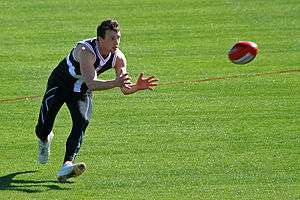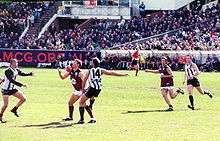Mark (Australian football)

A mark is a skill in Australian rules football where a player cleanly catches (is deemed to have controlled the ball for sufficient time) a kicked ball that has travelled more than 15 metres without anyone else touching it or the ball hitting the ground.
It is a distinctive part of the game. Although catching the ball is also found in other codes of football, along with kicking the ball, it is one of the most prevalent skills in Australian football. Marking can also be one of the most spectacular and distinctive aspects of the game, and the best mark of the AFL season is awarded with the Mark of the Year, with similar competitions running across smaller leagues.
The top markers in the Australian Football League, like Jason Dunstall and Jonathan Brown take an average of over 8 marks per game.[1] An AFL match between St Kilda and Port Adelaide in 2006 set a record of 303 marks in a single game.[2]
Rules
Upon taking a mark, the umpire will blow the whistle to signify the mark and a player is entitled to an unimpeded kick of the ball, to advance his team towards their goalposts. The nearest opposition player stands on the spot where the player marked the ball, which is also known as the mark, and becomes the man on the mark. When taking the set kick, the player must either play on or kick the ball over the mark.
The criterion for a mark is that it be caught cleanly, i.e. the player have complete control of the ball, for any length of time. As such, if the ball is caught in one grab, and then punched out from between the player's hands, a mark is paid, even if he has held it for only an instant. Similarly, if a ball is controlled, and then dislodged by another player or the ground, the mark will still be paid.
Although the rules make no provision for two players mark the ball simultaneously,[3] by convention the umpire will award the mark to the man in front, i.e. the player who has the front position in the marking contest; if he cannot determine which player is in front, then a ball-up will result.
The mark has been included in the compromise rules used in the International Rules Football series between teams from Australia and Ireland since 1984.
Origins of the mark
Various forms of football descended from English public school football games of the 19th century have featured a fair catch or mark. It was abolished early in the development of soccer but still exists in rugby union and American football.
The mark has been one of the most distinctive features of Australian football since rules were drawn up in 1859.
Some people claim that the origin of the term 'mark' comes from the practice of a player who has just taken a mark physically marking the ground with his foot, or cap which formed part of the attire worn by players in the 19th century, to show where he took the fair catch.
Others claim that the origin of the mark comes from the traditional Aboriginal game of Marn Grook, which is said to possibly have influenced Tom Wills writing of the laws of the game. It is claimed that in Marn Grook, jumping to catch the ball, called "mumarki", an Aboriginal word meaning "to catch" results in a free kick. Some counterclaim this theory as false etymology.
Types of marks




In Australian football, marks are often described in combination of the following ways.
- Overhead Mark - catching the ball with hands extended above the head
- Contested Mark - catching the ball against one or more opponents who are attempting to also mark or spoil the player attempting the mark.
- Pack Mark - catching the ball against one or more opponents and/or teammates all close to the fall of the ball.
- High Mark - catching the ball whilst jumping up in the air. Stewart "Buckets" Loewe, Matthew Richardson and Simon Madden are notable exponents of the high mark.
- Spectacular mark - sometimes nicknamed 'specky', 'screamer' or 'hanger', this term is most often used when a mark taken (sometimes contested) whilst jumping in the air. Additional elevation is achieved by using the legs to spring off the back or shoulders of one or more opponents and/or teammates. The movement of other players beneath the player marking can cause them to lose balance in mid air and land or fall awkwardly, enhancing the spectacle of the mark. The name reflects its popularity among spectators.
- Chest Mark - catching the ball and drawing it in to the chest. This is considered the easiest mark to take, and is often used in wet weather. At professional level this skill is discouraged by coaches due to it giving opponents a much better chance of intercepting the ball from most directions.
- Out in Front - catching the ball with arms extended forward from the body. This skill is extremely difficult, particularly with the ball travelling low and at high speeds. At professional level this skill is preferred by coaches, as it gives opponents less chance of spoiling from behind, and if the ball spills, it will be "front and centre" of the player, which makes it much easier for rovers to predict and to execute game strategy.
- One Handed Mark - catching the ball with only one hand. Rarely used in a contested situation where one player's arm is impeded by an opponent (which is typically a free kick anyway). While spectacular, this skill is discouraged by coaches due to a low percentage of success and is sometimes seen as "showing off" or "lairising".
- Diving Mark - leaping horizontally to catch the ball before it hits the ground.
- With the flight of the ball - a mark taken running in the direction that the ball is travelling. In order to do this, the player must take their eyes off opposition players sometimes running at fast pace in the opposite direction. This type of mark is often branded "courageous", because in attempting the mark, the player must ignore the danger of a high speed collision with oncoming players. Wayne Carey and Jonathan Brown were known for their ability to take courageous marks.
- Standing one's ground - a mark taken by a player who is standing still. These are particularly difficult, because the player must wait in a stationary position, making it much easier for moving opponents to make better position. There is also a higher risk of collision with incoming players, meaning it requires courage.
- Backing into a pack - a mark taken by a player who is running or jogging backwards while facing the ball. These are particularly dangerous with an extremely high risk of collision from behind by players running at the ball at high speed. It is also highly difficult to keep eyes on the ball whilst expecting a high collision from behind.
- Half Volley - technically not a mark. Sometimes players catch the ball so close to the ground that it is difficult to tell whether it hit or bounced off the ground. Sometimes a player is awarded a mark by an umpires benefit of the doubt.
- Juggled Mark - when a player takes two or more touches of the ball to claim the mark. The player must appear to have had control of the ball to be awarded the mark. Importantly, the mark must be completed within the field of play to be paid as a mark; it should not be paid if the first touch was inside the boundary line, but the last outside.
- Fingertip Mark - when the player is only barely able to hold the ball with his fingers at full stretch. This type of mark carries a high risk of injury to fingers.
- Slips Catch - a fingertip mark taken low to the ground, with terminology borrowed directly from cricket.
Famous marks
While the Mark of the Year competition has produced many famous marks, other marks include:
In the 1970 Grand Final before a record crowd, Carlton full forward, and giant of the game, Alex Jesaulenko, took one of the most inspirational marks in the history of 'the Australian game' leaping high for a specky over Collingwood's Graeme Jenkin just before half time, to help inspire a Carlton side that was behind by 44 points at the half.
Sydney's Leo Barry leapt into history with his match-saving mark in the final seconds of the 2005 grand final against the West Coast Eagles to seal the game. His contested overhead mark was taken in a congested pack of 3 teammates and 3 opposition players.
Shaun Smith's and Gary Ablett's shared title of Mark of the Century.
St Kilda/South Melbourne player Roy Cazaly was renowned for his high marks, giving rise to the catchphrase and song "Up There Cazaly".
Spoiling the mark
Spoiling is the technique typically employed by opposition defenders to legally stop a player from catching the ball. Spoiling is performed by hand or fist (as a punching action) either before or shortly after the player has caught the ball in their hands.
The rules are quite strict on defensive spoiling methods. Players are not allowed to push other players out of marking contests or make forceful front on contact with an opponent in a marking contest, if they are not simultaneously attempting to mark or spoil the ball. Also, no high contact is allowed unless such contact is incidental to attempting to mark or spoil the ball.
Taking the arms
Deliberately taking, hacking or chopping the arms is an infringement committed by defenders which will result in a free kick.
The arm interference free kick was introduced as a specific free kick in the AFL and its affiliates in 2005, although it was paid as a blocking, striking or holding free kick previously. The free kick was designed predominately to make it easier for forwards to take contested marks by not allowing defending player to punch or pull a marking player's outstretched arms in a marking contest.[4]
The rule was introduced by the AFL amidst on-going calls from fans and commentators to take action against the defensive tactic of flooding; the rule does directly limit the effectiveness of defenders, but the AFL has never stated whether or not flooding was the reason for the change.[4]
Marking-related injuries
Marking can cause injuries to hands and fingers, including hyperextension, joint and tendon damage, dislocation and fractures. Over a long period of time and with re-injury there can be long-term effects such as chronic injury and debilitating arthritis. To overcome these injuries, some players will strap problem fingers together, whole hands, wear splints or gloves.
Some of these injuries require surgery and extended recovery, threatening professional careers. AFL players whose careers were threatened by such injuries include Robert Campbell, Fraser Gehrig, Brett Backwell and Daniel Chick. Some players, such as Backwell and Chick, have opted for amputation of digits in a bid to extend their playing careers and continue to mark the ball.
References
- ↑ Player statistics
- ↑ Team game records
- ↑ AFL. "Laws of Australian Football" (PDF). Australian Football League. Retrieved 2 February 2012.
- 1 2 "AFL News, Scores, Stats, Transfers". The Age. Melbourne.